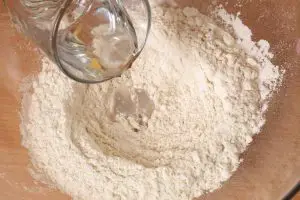When people consider sourdough vs. soda bread, they often wonder if they are the same thing. However, soda bread is a type of quick bread that doesn’t use yeast as a raising agent, while sourdough does. They have similar ingredients, flavors, and reactions, but they achieve them through different methods.
Differences Between Sourdough and Soda Bread
Although people often wonder if sourdough and soda bread are the same thing, there are some distinct differences between them. The primary difference is the leavening agent, but there are other differences as well. Take a look at four differences between them.
1. The Leavening Agent
The main difference between sourdough and soda bread is the leavening agent. Sourdough rises after gasses are released from the yeast and bacteria fermentation, and soda bread rises from gasses that are produced when there is a chemical reaction from baking soda and the acids in the dough.
When you bake sourdough, the leavening agents are wild yeast and bacteria that are naturally found in the sourdough starter culture. In this process, yeast and bacteria will consume the sugars in the dough, and this process produces carbon dioxide gasses that remain trapped in the dough by the gluten. The end result is that the bread rises.
Soda bread rises when the baking soda and the acids in the dough interact. This happens because baking soda is an alkaline base, and it undergoes a chemical reaction when acids and water are present. This reaction produces carbon dioxide gasses, which are trapped inside the bread by the gluten and cause the dough to rise.
2. Ingredients
Another difference between sourdough and soda bread are the ingredients in each. Sourdough has high-protein flour, water, salt, and sourdough starter. Soda bread uses all-purpose flour, milk and buttermilk, salt, baking soda, and acid.
The reason why sourdough uses a high-protein flour is that it has more gluten, which allows it to trap more gasses. The all-purpose flour in soda bread has less gluten, so you get the dense crumb that soda bread has.
Sourdough is hydrated by water, while soda bread is hydrated by milk and buttermilk. They help bring the dough together, but they also assist in the chemical reaction that causes the bread to rise. Finally, the leavening agent for sourdough is the sourdough starter, while it is baking soda and acid for soda bread. Baking soda is a weaker leavening agent than sourdough starter.
3. Fermentation and Preparation
There is also a difference in how these two breads ferment. Sourdough relies on fermentation to rise, so it has to go through a lengthy process as it takes between six and eight hours to complete. It is important to stay on top of the temperature and degree of rise in the dough to make sure that it isn’t underproofed or overproofed.
Soda bread is a quick bread, and it doesn’t need any time for fermentation. In fact, it can be baked as soon as you finish mixing it. When you mix the baking soda and the liquid, it will react immediately to produce the carbon dioxide gasses that cause the bread to rise.
Another difference is in their preparation. You need to mix sourdough bread mix longer so that the gluten matrix develops fully in the high-protein flour. This is what causes the dough to rise up and become light, airy, and fluffy. On the other hand, soda bread is mixed for a short time, and as soon as the ingredients are combined, it is ready. It is the opposite effect because you don’t want the bread to rise.
4. Flavor and Texture
A fourth difference between sourdough and soda bread is the flavor and texture. Sourdough is known for its light and airy crumbs, while soda bread is more dense because all-purpose flour has less protein and it is mixed for less time. As a result, there is less gluten, and the dough doesn’t trap gasses and rise as quickly.
The flavor differs as well; sourdough is more complex because of the fermentation reactions that take place. The process produces gasses that allow the bread to rise and it produces organic acids that give sourdough the pleasant yet sour flavor. Soda bread uses milk and buttermilk, which creates a rich, milky taste in the bread. They taste quite different and have different textures.
Which Bread Is Better for You?
The main difference between sourdough and soda bread is the fermentation process that sourdough goes through versus the simple mixing process of soda bread. The fermentation process actually has benefits that come with it, which makes it somewhat better for you.
Sourdough has a lower glycemic index because the fermentation process consumes many of the starches and sugars. This allows you to stay full longer when you eat it because your body sugar levels are more stable. This is good for you.
In addition, sourdough uses flour and gluten that are broken down so that they are easier to digest. It also releases more nutrients, which are easier for your body to absorb. Soda bread has the benefit of being quick to prepare, but sourdough has health benefits to accompany its delicious taste.
Final Words
Although people often wonder if sourdough and soda bread are the same thing, they are not. They have different ingredients, different processes, different preparation, and different flavors and textures. Soda bread is a quick bread that doesn’t require much time, but sourdough is healthier.






